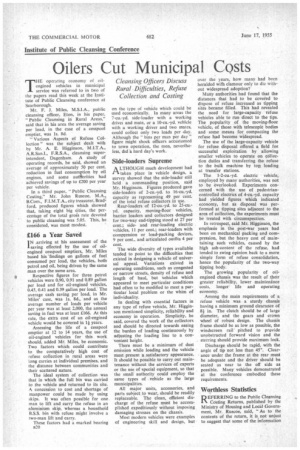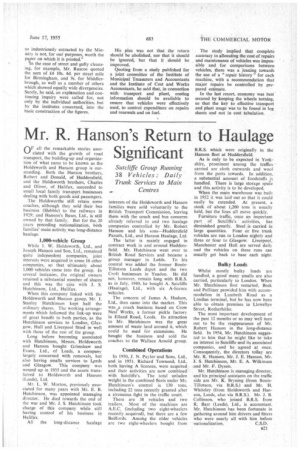Institute of Public Cleansing Conference
Page 54

Page 55

If you've noticed an error in this article please click here to report it so we can fix it.
Oilers Cut Municipal Costs
Cleansing Officers Discuss Rural Difficulties, Refuse Collection and Costing
THE operating economy of oilengined vehicles in municipal service was referred to in two of the papers read this week at the Institute of Public Cleansing conference at Scarborough.
Mr. F. J. Miles, M.S.I.A., public cleansing officer. Eton, in his paper, "Public Cleansing in Rural Areas," said that in his area the average saving per load, in the case of a cesspool emptier, was Is. 8d.
" Various Aspects of Refuse Collection" was the subject dealt with by Mr. A. E. Higginson, M.I.T.A., A.R.San.I., F.R.S.A., cleansing superintendent, Dagenham. A study of operating records, he said, showed an average of approximately 50 per cent. reduction in fuel consumption by oil engines, and some autItorities had achieved savings of up to £200 per year per vehicle.
In a third paper, " Public Cleansing Costing," Mr. John Ruscoe. M.A., B.Com., F.I.M.T.A., city treasurer. Bradford. produced figures which showed that, taking eight big cities, the percentage of the total gross rate devoted to public cleansing was 5.05. This, he considered, was most modest.
£166 a Year Saved
I N arriving at his assessment of the saving effected by the use of oilengined cesspool emptiers, Mr. Miles based his 'findings on gallons of fuel consumed per load, the vehicles, both petrol and oil, being driven by the same man over the same area.
II Respective figures for three petrol vehicles were 0.90, 0.91 and 0.89 gallon per load and for oil-engined vehicles, 0.45, 0.41 and 0.39 gallon per load. The average cash saving per load, in Mr. Miles' case, was Is. 8d., and as the average number of loads per vehicle per year was at least 2,000, the annual saving in fuel was at least £166. At this rate, the extra cost of an oil-engined vehicle would be covered in 1i years.
Assessing the life of a cesspool emptier at 12 to 14 years, the use of oil-engined vehicles for this work should, added Mr. Miles, be economic. Two factors which could contribute to the comparatively high cost of refuse collection in rural areas were long carries at individual premises, and the distance between communities and their scattered nature.
The ideal system of collection was that in which the full bin was carried to the vehicle and returned to its site. A concession to cost and shortage of manpower could be made by using skips. It was often possible for one man to lift and carry the refuse in an aluminium skip, whereas a household B.S.S. bin with refuse might involve a two-man lift and carry.
These factors had a marked bearing B20 on the type of vehicle which could be used economically. In many areas the 7-cu.-yd. side-loader with a working drives and mate, or a 10-cu.-yd. vehicle with a working driver and two mates, could collect only two loads per day. Although the " bins per man per day" figure might shock officers accustomed to town operation, the men, nevertheless, did a hard day's work.
Side-loaders Supreme
A LTHOUGH much development had
taken place in vehicle design, a survey showed that the side-loader still held a commanding position, said Mr. Higginson. Figures produced gave side-loaders of 2-cu.-yd. to 16-cu.-yd. capacity as representing 49 per cent. of the total refuse collectors in use.
Rear-loaders of 12-cu.-yd. to 25-cu.yd, capacity, moving-floor vehicles, barrier loaders and collectors designed for two-way end-tipping stood at 27 per cent.; sideand rear-loading electric vehicles, 11 per cent.; rear-loaders with compression or load-packing devices, 9 per cent., and articulated outfits 4 per cent.
The wide diversity of types available tended to point to the difficulties that existed in designing a vehicle of universal appeal. Variations existed in operating conditions, such as congested or narrow streets, density of refuse and length of haul, but vehicles which appeared to meet particular conditions had often to be modified to meet a particular local problem or the whim of In dealing with essential factors in any type of refuse vehicle, Mr. Higginson mentioned simplicity, reliability and economy in operation. Simplicity, he said, covered the work of the collectors and should be directed towards easing the burden of loading continuously by adjusting the loading line to a convenient height.
There must be a minimum of dust emission while loading and the vehicle must present a satisfactory appearance. It should be possible to carry out maintenance without the services of experts or the use of special equipment, so that the small authority could employ the same types of vehicle as the large municipalities.
All major units, accessories, and parts subject to wear, should be readily replaceable. The clean, efficient discharge of the refuse must be accomplished expeditiously without imposing damaging stresses on the chassis.
Most modern vehicles were examples of engineering skill and design, but over the years, how many had been heralded with clamour only to die without widespread adoption?
Many authorities had found that the distances that had to be covered to dispose of refuse increased as tipping sites became filled. This had revealed the need for large-capacity refuse vehicles able to run direct to the tips. The popularity of the moving-floor vehicle, of those with telescopic bodies and some means for compacting the refuse had become widespread.
The use of the large-capacity vehicle for refuse disposal offered a field for successful exploitation by allowing smaller vehicles to operate on collection duties and transferring the refuse to the bulk machine by top loading at transfer stations.
The 1-2-cu.-yd. electric vehicle, employed by many authorities, was not to be overlooked. Experiments concerned with the use of pedestriancontrolled electrics of 4-cu.-yd. capacity had yielded figures which indicated economy, but as disposal was performed at tipping sites adjacent to the area of collection, the experiments must be treated with circumspection.
In retrospect, said Mr. Higginson, the emphasis in the post-war years had been on mechanical packing and compression, but the heavy cost of maintaining such vehicles, caused by the high ash-content of the refuse, had tended to swing opinion back to a more simple form of refuse consolidation, hence the popularity of the two-way tipping body.
The growing popularity of cm Iengined chassis was the result of their greater reliability, lower maintenance costs, longer life and operating economy.
Among the main requirements of a refuse vehicle was a sturdy chassis having a minimum ground clearance of 81 in. The clutch should be of large diameter, and the gears and crown wheel of robust design. The chassis frame should be as low as possible, the windscreen rail pitched to provide unobstructed forward vision and the steering should provide maximum lock.
Discharge should be rapid, with the angle of tip not less than 450, Clearance under the frame at the rear must be adequate and the driver should be seated as near to the off side as possible. Many vehicles demonstrated at the conference embodied these requirements.
Worthless Statistics
DEFERRING to the Public Cleansing 1 Costing Returns, published by the Ministry of Housing and Local Government, Mr. Ruscoe, said, "As to the contents of the return, it is not unjust to suggest that some of the information
so industriously extracted by the Ministry is not, for our purposes, worth the paper on which it is printed."
in the case of street and gully cleansing, for example, Mr. Ruscoc quoted the sum of £4 10s. 4d. per street mile for Birmingham, and 9s. for Middlesbrough, as well as a number of others which showed equally wide divergencies. Surely, he said, an explanation and continuing inquiry were called for, not only by the individual authorities, but by the institutes concerned, into the basic construction of the figures. His plea was not that the return should be abolished, nor that it should be ignored, but that it should be improved.
Quoting from a study published for a joint committee of the Institute of Municipal Treasurers and Accountants and the Institute of Cost and Works Accountants, he said that, in connection with transport and plant, costing information should be available to ensure that vehicles were effectively used, to control expenditure on repairs and renewals and on fuel. The study implied that complete accuracy in allocating the cost of repairs and maintenance of vehicles was impossible and for comparisons between vehicles, there was a leaning towards the use of a "repair history" for each machine, with a recommendation that major repairs be controlled by prepared estimate.
In the last resort, economy was best secured by keeping the wheels turning. so that the key to effective transport and plant usage was to be found in log sheets and not in cost tabulation.




























































































